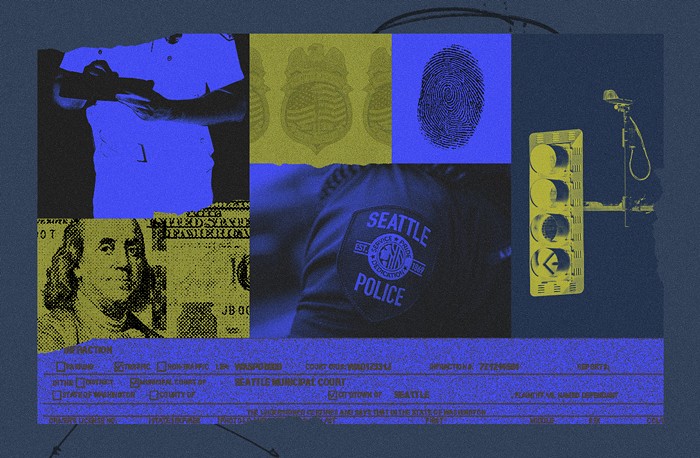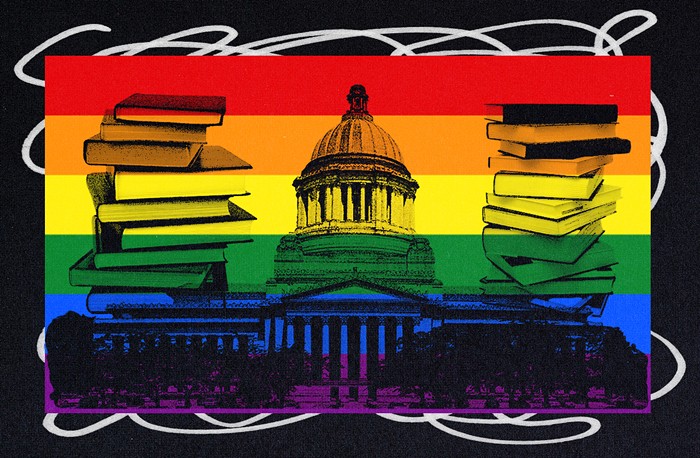The flyer--and the young woman's call to arms--was the first official notice that, yes indeed, the approximately 500,000 people marching up Seventh Avenue to protest the Republican Convention and George Bush's war in Iraq would defy the mayor, the court, and the police and gather in Central Park where protest organizers had been seeking a rally permit for a year. New York's State Supreme Court officially turned down the organizers, United for Peace and Justice, on Wednesday after a last-minute appeal hearing.
Coy threats to defy the court fueled the demonstration all morning, lending a buzz of subversion to the march. In a reference to the city's comical argument that protesters would damage the turf in Central Park, one huge sign read, "Grass grows back. Free speech won't." Meanwhile, a world-beat rock band, Outernational, firing up protesters at a Sunday morning kickoff in Union Square announced, "Our set was supposed to be in Central Park"; and all the morning's scheduled speakers--like Michael Berg, father of Nick Berg, the freelance contractor who was beheaded by Iraqi insurgents earlier this year--signed off their speeches with a bit of teenage defiance: "See you in the Park!"
Even the mellow group I was shadowing, about six protesters with Seattle NION (Not in Our Name), had been nodding and winking about heading to Central Park. "Oh, there'll be some arrests later in the day," Seattle NION spokesperson Margo Polley chuckled when I noted that things seemed pretty peaceful.
The defiant tone echoed actions that had gone down during the week leading up to the march. On Thursday, August 26, four protesters were arrested for repelling down the Plaza Hotel and unfurling an anti-Bush banner. Also on August 26, 11 AIDS activists, 5 men and 6 women, were arrested after staging a nude protest in front of Madison Square Garden (the GOP Convention site) where they locked arms and blocked traffic for 15 minutes. And on Friday, about 100 bicyclists were arrested for blocking intersections, zigzagging up and down city streets, and snarling traffic near Madison Square Garden and in the East Village.
This run of civil disobedience left Kerry fans nervous about Sunday. Fears of another "Seattle" had Democrats dreading the prospect of TV images of violence in Manhattan: Slovenly anarchists mix it up with New York's finest amidst clouds of tear gas. Film at 11:00.
It would have been a PR freebie for George Bush if, on the eve of his nominating convention at Madison Square Garden, the president's detractors were seen scrapping with the NYPD. And it wouldn't have been much of a trick for Karl Rove to associate Kerry's campaign with the countercultural protesters and any tumult in the streets.
As Sunday approached, and after the Central Park court decision went against the protesters, "the Battle of Seattle"--even Chicago '68--was being mentioned. Remember what happened in 1999 when Seattle police declared downtown a "No Protest Zone"? Late-night riots broke out. Now, NYC officials were telling anti-Bush demonstrators to stay out of Central Park--which is pretty much like a father telling his teenage daughter that she's forbidden from dating a particular boy. Riots were sure to ensue. Kerry and the Democrats had plenty to be nervous about. Narnia I got to New York City on Saturday, 24 hours before the massive demo. And indeed, a "Seattle" mood was unmistakable. Literally.
The first thing I came across was an anti-Starbucks rally at a Starbucks on Fifth Avenue and West 33rd Street. "Arrest Howard Schultz!" protesters chanted as they waved black and red anarchy flags, beat snare drums, and sported ripped T-shirts blaring slogans like "Starfucks." There was also a man dressed in a giant coffee-cup suit leading chants of "What's outrageous? Poverty wages." A pack of media microphones and news cameras orbited. A stern line of cops, standing in front of the store, frowned glumly at the protesters.
Anarchists? Starbucks? People dressed in silly costumes? No-protest zones? Police lines? I was certainly ready for "Seattle Part 2"--and, as a direct result, Kerry's political demise.
But my fears were misplaced. On Sunday, there was no standoff in Central Park. The scene there after the march was more like Narnia and nothing like Najaf. While a couple thousand protesters did gather on the Great Lawn near the west side of the Park, it was mostly to buy Poland Spring water from food-cart vendors and space out on the damp grass. Trios of mellow police officers hung out on the sidelines, also queuing up at the vending carts, buying water and ice cream--shoulder to shoulder with the spent protesters. The rowdiest thing happening in the Park was over on the east side where a Rollerblade dance troupe in spandex was dirty-dancing to distorted boom-box disco while Upper East Side couples stopped to gawk.
More important, the march itself, which passed directly by the GOP Convention site at Madison Square Garden on Seventh Avenue (and under a huge Fox News billboard at West 33rd Street drawing catcalls like "Exploit this photo op, bastards!"), came off beautifully. Despite the muggy 90-degree heat, the march was mobbed, loud, and peaceful. I hate to be a booster, but the size of the protest blew me away. I knew it was big, but not how big. When a report from someone back in Seattle of the NYC Department of Transportation website's description of wall-to-wall people got relayed to Richard, the thin and gray-bearded 57-year-old Vietnam-era Seattle activist marching next to me, I got a pang of glee. I was hoping that Richard, who I met on the redeye out of Sea-Tac on Friday night when I noticed his tweed coat, purple shirt, and cap covered in political pins, was right about his protester-per-square-foot calculation of a million people. (Accompanied by a front-page color photo of marchers stretching down Seventh Avenue along with a headline calling the march "vast," "raucous," and "peaceful," the New York Times would report 500,000 the next day--"the city's largest political protest in decades.")
By any measure, it was a successful antiwar rally and, better, a direct challenge to the Bush agenda. Basically, a crowd equaling the population of Seattle took over a 40-block loop from Union Square to Penn Station, sending a clear message to the GOP: Bush is a problem. The best sign I saw said, "Got Democracy?" with a picture of the infamous hooded Abu Ghraib prisoner hooked up to electrodes.
This type of octane hadn't propelled the anti-Bush movement since Howard Dean raised his voice. Now, the energy was back in full force to greet the GOP Convention just two months before Election Day. What great news. But then the bad news hit me. This was an antiwar march, and John Kerry is not an antiwar candidate. He's not even an anti-Bush candidate: The ultra-cautious Kerry has shied away from challenging the administration on the quagmire in Iraq, or even on outright scandals like Abu Ghraib.
Despite the energy the left brought to the streets of New York, Democrats are exactly where they were months ago. They can't stand George Bush, but they don't have a candidate that successfully carries the message and fires them up. A raucous anti-Bush rally of a half-million people thundered up Seventh Avenue and back down Broadway chanting, "Bush lied. Troops died." But their cause seemed unconnected to the politics of John Kerry. And given Kerry's stance on the war and his vote for the PATRIOT Act, the overwhelming sentiment at the rally was actually lukewarm on Kerry.
This is a stark reminder for Democrats that the "Anybody but Bush" theme still transcends their candidate. Ultimately, voters don't vote against candidates. They need a candidate to vote for. If the march in New York City this week demonstrated anything, it's that John Kerry is irrelevant to the Zeitgeist this election season. This is bad news for Kerry. The march in New York City, which even earned wowed headlines in the conservative New York Post, was more a Dean rally, a Kucinich rally, a Nader rally.
"Kerry voted for the war," a member of the Seattle NION contingent, Jennifer Kissinger, tells me. "I don't support Kerry," another Seattle NION marcher, 40-year-old Eastside tech worker Michael Lubrano, says as we make our way from Union Square over to Seventh Avenue. "I support Kucinich," he says. A third Seattle NION member who made it to New York, Jill Killen, a 35-year-old Dean supporter from North Seattle, adds, "Kerry is Bush lite." It seems Kerry is scarcely represented among the Seattle group that has come to New York.
Finding Kerry The next day, I find Kerry's NYC presence. It's actually located smack-dab in the middle of Sunday's protest route, 15 stories up on a hastily refurbished floor of a turn-of-the-century building in Chelsea on Seventh Avenue at West 26th Street. It's here that the Democratic National Committee (DNC), working closely with Kerry, has set up its Convention Response headquarters. In one of the rooms, a team of researchers and media-relations flacks, monitoring eight TVs and manning rows of computers, is ready to pounce in real time on any Republican spin coming out of Madison Square Garden. "We'll be actively truth-squading their speeches," says spokesperson Matt Bennett, as he gives a gaggle of reporters a tour of the slapdash digs. The DNC Convention Response setup is obviously modeled on Clinton's much-lauded 1992 rapid-response war room. (Or perhaps it's just a tardy response to Kerry's Swift Boat fiasco.)
A series of sound bites, typed out on white sheets of paper, are posted on the wall: "Drove Health Insurance Premiums Up by 50 percent"; "Lost 1.8 Million Private-Sector Jobs"; "Fewer Jobs. Smaller Paychecks"; "Prohibiting Patients from Buying Cheaper Prescription Drugs from Canada." These slogans are presumably modeled after Clinton, too. A slogan--"It's the Economy, Stupid!"--famously graced the wall of James Carville's '92 Clinton war room.
Unfortunately, the comparison to Clinton's war room highlights the same thing that Sunday's march highlighted: Kerry's not dialed in. In 1992, it was "The economy, stupid!" In 2004, however, as the half-million people who hit the streets made clear, "It's the war, stupid!" And Kerry appears unwilling to take up that fight with Bush. On the morning after the protest, DNC leader Terry McAuliffe laid out the themes of the campaign at a press conference: "We're going to spend our time on job creation, health care, and education"--which the Tuesday, August 31, edition of the Hill, a D.C. paper that covers Congress, said is "an indication that Democrats plan to focus on domestic issues," adding, "McAuliffe's statement could signal a strategic shift away from... national security."
In a moment of hope, I think maybe I'm wrong about this. In addition to all the factoids tacked up on the walls, there is another sign around the office. "Mission NOT Accomplished," the poster blares. It seems a clear swipe at Bush's war, appropriating W's famous misstatement on Iraq from March 2003. Unfortunately, DNC research leader Tracy Sefl corrects me. "We're talking about what Bush has done abroad and at home," she begins. Then she adds specifically, "We're talking about jobs, affordable health care."
Jobs? Affordable health care? "Abroad?" Just the day before, in the largest antiwar protest the country has seen in decades, a half-million people passed right by this office. But on Monday, the opposition party war room won't join the chorus and talk specifics about Bush's war?
It's understandable that the Kerry camp is sensitive about protesters. He doesn't want to be linked to some random activist who knocks down and punches a bike cop or anarchists who dress up as coffee cups. But the gut impulse to shy away from the issue of the day and the timidity about staring Bush down on Iraq make it clear that the Kerry campaign fails to understand the engine of this year's election.
Bennett says, "To be crystal clear, we had nothing to do with [the march]. Other than having front-row seats, we had nothing to do with it." He did say that DNC staffers were riveted by the river of people flowing past their Seventh Avenue building on Sunday. "We were watching amazed," he says.
That's the problem.


















